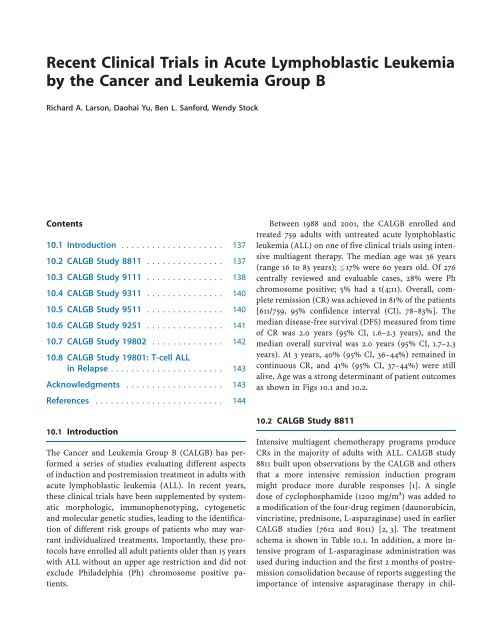Acute Leukemias - Republican Scientific Medical Library
Acute Leukemias - Republican Scientific Medical Library
Acute Leukemias - Republican Scientific Medical Library
Create successful ePaper yourself
Turn your PDF publications into a flip-book with our unique Google optimized e-Paper software.
Recent Clinical Trials in <strong>Acute</strong> Lymphoblastic Leukemia<br />
by the Cancer and Leukemia Group B<br />
Richard A. Larson, Daohai Yu, Ben L. Sanford, Wendy Stock<br />
Contents<br />
10.1 Introduction .................... 137<br />
10.2 CALGB Study 8811 ............... 137<br />
10.3 CALGB Study 9111 ............... 138<br />
10.4 CALGB Study 9311 ............... 140<br />
10.5 CALGB Study 9511 ............... 140<br />
10.6 CALGB Study 9251 ............... 141<br />
10.7 CALGB Study 19802 .............. 142<br />
10.8 CALGB Study 19801: T-cell ALL<br />
in Relapse ...................... 143<br />
Acknowledgments ................... 143<br />
References ......................... 144<br />
10.1 Introduction<br />
The Cancer and Leukemia Group B (CALGB) has performed<br />
a series of studies evaluating different aspects<br />
of induction and postremission treatment in adults with<br />
acute lymphoblastic leukemia (ALL). In recent years,<br />
these clinical trials have been supplemented by systematic<br />
morphologic, immunophenotyping, cytogenetic<br />
and molecular genetic studies, leading to the identification<br />
of different risk groups of patients who may warrant<br />
individualized treatments. Importantly, these protocols<br />
have enrolled all adult patients older than 15 years<br />
with ALL without an upper age restriction and did not<br />
exclude Philadelphia (Ph) chromosome positive patients.<br />
Between 1988 and 2001, the CALGB enrolled and<br />
treated 759 adults with untreated acute lymphoblastic<br />
leukemia (ALL) on one of five clinical trials using intensive<br />
multiagent therapy. The median age was 36 years<br />
(range 16 to 83 years); < ˆ 17% were 60 years old. Of 276<br />
centrally reviewed and evaluable cases, 28% were Ph<br />
chromosome positive; 5% had a t(4;11). Overall, complete<br />
remission (CR) was achieved in 81% of the patients<br />
[611/759, 95% confidence interval (CI), 78–83%]. The<br />
median disease-free survival (DFS) measured from time<br />
of CR was 2.0 years (95% CI, 1.6–2.3 years), and the<br />
median overall survival was 2.0 years (95% CI, 1.7–2.3<br />
years). At 3 years, 40% (95% CI, 36–44%) remained in<br />
continuous CR, and 41% (95% CI, 37–44%) were still<br />
alive. Age was a strong determinant of patient outcomes<br />
as shown in Figs 10.1 and 10.2.<br />
10.2 CALGB Study 8811<br />
Intensive multiagent chemotherapy programs produce<br />
CRs in the majority of adults with ALL. CALGB study<br />
8811 built upon observations by the CALGB and others<br />
that a more intensive remission induction program<br />
might produce more durable responses [1]. A single<br />
dose of cyclophosphamide (1200 mg/m 2 ) was added to<br />
a modification of the four-drug regimen (daunorubicin,<br />
vincristine, prednisone, L-asparaginase) used in earlier<br />
CALGB studies (7612 and 8011) [2, 3]. The treatment<br />
schema is shown in Table 10.1. In addition, a more intensive<br />
program of L-asparaginase administration was<br />
used during induction and the first 2 months of postremission<br />
consolidation because of reports suggesting the<br />
importance of intensive asparaginase therapy in chil-
















